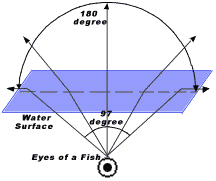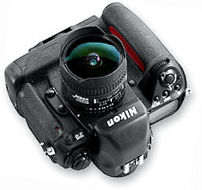 |
Fisheye lenses and their Optical Properties |
Nikon has more than seven fisheyes lenses in total, each with varying lens speed, features, technical specifications and lens type for different kind of photographic applications. Generally, you can safely classified them into a two main catagories: Full frame Fisheye or Circular Fisheye lenses. Next, whether if the version you owned requires a Mirror-Lock Up feature inside camera in order it to be used or don't. Original series of fisheye lenses were slow in their maximum aperture and have fixed focus design, the slow lens speed may make photo composition inside camera viewfinder difficult. Generally, they would also require a mirror-lock up mechanism on the camera section in order to avoid the extended protruded back portion of these lenses interfering with the reflex mirror movement during an exposure process. Naturally, lenses of this design need auxiliary finder to provide visual aid for composing but focusing is via predetermine distance and make use of depth of field scale engraved on the lens barrel. Subsequent replacement of Fisheye Nikkor lenses that emerged have much better design and equipped with a brighter maximum aperture to enable easy, bright picture viewing/composing. More importantly, they were being designed as a reflex optic for SLR (retrofocus lens) which means truthful, nonreverted reflex viewing is possible with any working SLR camera. Further, there is no neccessity to utilize Mirror-Lock to enable these lenses to be used onto any Nikon SLRs. Naturally, the newer series of these Fisheye-Nikkor lenses are believed to have a much improved optical performance when compared to older series in areas such as close focusing ability, lens coating process and maximum les speed etc.
 |
Originally designed for scientific studies, fisheye lenses were once called "full sky lens". It was primarily used for astrophotography and astronomical observations. Today, however, the fisheye lens is widely used by professional photographers, researchers and even many serious amateurs when special wide filed effects are desiredin their images. Imaginative use of the various optical characteristic of a fisheye lens can create a world of mystery from the most conventional subject matter. |
Looking through the viewfinder of a camera equipped with a fisheye lens can be quite an experience. You see everything from the ground at your feet (Some lenses even have your feet covered in, too), to the sky overhead and virtually everything to your right and left within a radius of either 220 -180° depends on the lens type. All the images in the viewfinder produced by such lens type are circular in the middle of the picture frame and that's the way it will be reproduced on film (Except the 16mm fisheye which is a full frame fisheye lens that will generate an image that will fill up the entire 24mm x 36mm picture frame). The fisheye lens' view is like that of a fish looking through the water to the surface as shown in the illustration below. Because of the refraction between water and air the fish has a tremendously wide angle of view. The front element of a fisheye lens has an extreme amount of curvature which accounts for its 180° vision. All these lenses (Except full frame fisheye) have a built-in filter turret and they will project a circular fisheye image in the center of the picture.
 |
The large, concave lens in front covers the subject area and then bends the light into approximately a 90° cone. The convex lens at the rear then forms the image on film. The same degree of coverage in a conventionally designed lens would require a much larger image area. Instead, with this lens, a limited circular image is projected on film. Due to the small image area, straight lines are rendered in a barrel or arch shape. |
- Tips: The fisheye lens bends straight lines, whether vertical or horizontal.
- Straight Lines at the center of the image show little or no distortion. If you want to emphasize the special effects of the fisheye using familiar subjects, choose a scene with a predominance of straight lines particularly away from the center of the subject area. In most cases, may not be a suitable lens for portraiture unless certain special effect is desirable, if persist to do so, least distortion is also around the center
- Curved or rounded objects may exhibit some fisheye effect in the photograph, but often not to a marked degree.
- While there is no focusing mechanism on some of the older fisheye lenses, it can be used effectively for close focusing.
- The extremely short focal length of these lenses provides tremendous depth of field.
- Warning: Lenses of this type may covers a field of view ranges from 180-220°. Check the finder for the intrusion of unwanted objects such as your feet, tripod legs or even part of the camera strap. Older versions of fisheyes required the reflex mirror to lock upward and you can only use an auxiliary accessory finder to compose and thus such fisheyes are not usable on all Nikon bodies except those that can lock the mirror out of the way to enable mounting of such lenses. The professional graded Nikon Nikon SLR camera such as Nikon F, F2, F3, F4, F5* and the Nikkormat are the only Nikon SLR bodies that equipped with such feature.
- Its extremely wide angle of view doesn't permit the use of a lens hood hence it cannot be protected from the direct rays of the sun or bright backlight.
 |
 |
<<< --- The current version of AF-D Fisheye-Nikkor 16mm f/2.8 Copyright-FREE images collection © 2001 |
Nikkor
Circular Fisheye Lenses: 6mm - f/2.8 | f/5.6 | 7.5mm f/5.6 | 8mm - f/2.8 | f/8.0 | 10mm
OP f/5.6
|
Full
frame 16mm
Nikkor-Fisheye
Lenses
-
f/3.5
Non-Ai
- f/3.5/f/2.8
Ai
- f/2.8
Ai-S
- f/2.8
AF-D
| Message Board |
for your
Nikkor
Optics
in a shared environment
| Message Board | Specifically for Dispose or Looking for new/used Nikon/Nikkor photographic equipment
| Nippon Kogaku Rangefinder Resources | Nikon F | Nikon F2 | Nikon F3 | Nikon F4 | Nikon F5 | Nikon F6 | Nikkormat / Nikomat | Nikon FM Series | Nikon FE/ FA | Nikon EM/FG/FG20 | Nikon Digital SLRs | Nikon - Other models |
Nikon MF RF-Nikkor lenses for Rangefinder
cameras:-
Main Index Page
Nikon
Auto Focus Nikkor lenses:- Main
Index Page
Nikon
Manual
Focus
Nikkor lenses:-
Fisheye-Nikkor Lenses - Circular |
Full Frame |
Ultrawides Lenses - 13mm15mm18mm20mm |
Wideangle Lenses - 24mm28mm35mm |
Standard Lenses - 45mm 50mm 58mm | Telephoto Lenses
- 85mm105mm135mm180mm & 200mm |
Super-Telephoto Lenses - 300mm 400mm 500mm 600mm 800mm 1200mm |
 |
Special Application
lenses: Micro-Nikkor Lenses - 50mm~55mm -60mm 85mm -105mm 200mm Micro-Zoom 70-180mm Perspective Control (PC) - 28mm 35mm PC-Micro 85mm Dedicated Lenses for Nikon F3AF: AF 80mm f/2.8 | AF 200mm f/3.5 EDIF Depth of Field Control (DC): 105mm 135mm Medical Nikkor: 120mm 200mm Reflex-Nikkor Lenses - 500mm 1000mm 2000mm Others: Noct Nikkor | OP-Nikkor | UV Nikkor 55mm 105mm | Focusing Units | Bellows-Nikkor 105mm 135mm Nikon Series E Lenses: 28mm35mm50mm100mm135mm | E-Series Zoom lenses: 36~72mm75~150mm70~210mm |
MF Zoom-Nikkor Lenses: 25~50mm | 28~45mm | 28~50mm | 28~85mm | 35~70mm | 36~72mm E | 35~85mm | 35~105mm | 35~135mm | 35~200mm | 43~86mm | 50~135mm | 50~300mm | 70~210mm E | 75~150mm E | 80~200mm | 85~250mm | 100~300mm | 180~600mm | 200~400mm | 200~600mm | 360~1200mm | 1200~1700mm
Tele-Converters: TC-1 | TC-2 | TC-200 | TC-201 | TC-300 | TC-301 | TC-14 | TC-14A | TC-14B | TC-14C | TC-14E | TC-16 | TC-16A | TC-20E
Recommended links to understand more technical details
related to the Nikkor F-mount and production Serial Number:
http://rick_oleson.tripod.com/index-153.html by: my
friend, Rick Oleson
http://www.zi.ku.dk/personal/lhhansen/photo/fmount.htm by: Hansen,
Lars Holst
http://www.mir.com.my/rb/photography/hardwares/nikonfmount/lens2.htm
http://www.photosynthesis.co.nz/nikon/serialno.html
Recommended Reading Reference on Nikon cameras and Nikkor lenses | about this photographic web site
| | Back | Main Index Page of Nikkor Resources | Back | Main Index Page of Pictorial History of Nikon SLRs |
| Home - Photography in Malaysia |
![]() Co-developed
with my web buddy, Rick Oleson® &
Co-developed
with my web buddy, Rick Oleson® & ![]() Denmark, Creator of the Nikon
Repair Group Mailing-List;
A
contributing effort to Michael Liu's Classic Nikon SLRs and
Nikkor optic site.
Denmark, Creator of the Nikon
Repair Group Mailing-List;
A
contributing effort to Michael Liu's Classic Nikon SLRs and
Nikkor optic site.
Credit: MCLau®, who has helped to rewrite
some of the content appeared this site. Chuck Hester® who has been helping
me all along with the development of all these Nikon websites; Lars Holst Hansen, 'Hawkeye'
who shares the same passion I have; Ms Rissa, Sales manager
from Nikon Corporation Malaysia for granting permission to use some of the official
content; Ted Wengelaar, Holland
who
has helped to provide many useful input relating to older Nikkor lenses; Some of the references
on production serial numbers used in this site were extracted from Roland Vink's website; Hiura Shinsaku from Nikomat
Club Japan. Lastly,
to all the good people who has contributed their own expeience, resources or kind
enough granted permission to use their images of their respective optic in this site.
It is also a site to remember a long
lost friend
on the Net. Note:certain content and
images appeared in this site were either scanned from official marketing leaflets
& brochures published by Nikon and/or contribution from surfers who claimed originality
of their work for educational purposes. The creator of the site will not be responsible
for may discrepancies arise from such dispute except rectifying them after verification. "Nikon", "Nikkormat", "Nippon Kokagu
KK"
& "Nikkor" are registered
tradename of Nikon Corporation Inc., Japan. Site made with an Apple IMac.